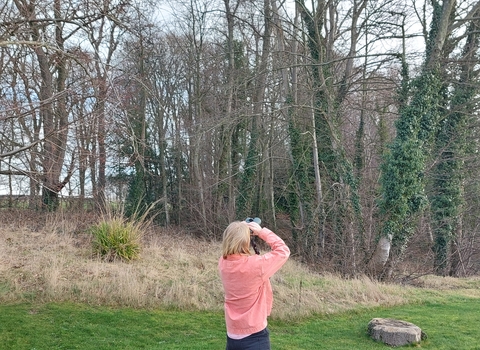
Protected Species Surveys
The Durham Wildlife Services team has extensive survey experience across a range of European and UK protected species, and thanks to our close links to Durham Wildlife Trust, unparalleled knowledge of the distribution of protected species across the North of England. Local knowledge is vital if effective surveys are to be delivered and the results viewed against local context.
DWS has extensive experience in survey, assessment, mitigation and habitat creation and management to benefit protected species, which ensures that your project is efficiently delivered with no impacts on wildlife.
Surveys undertaken include protected mammals such as bat, badger, otter, and water vole. We offer a full range of bird surveys and surveys for great crested newt, and reptiles, and white-clawed crayfish. All species will require an initial survey to identify the site’s potential for supporting said species. This is often carried out as a PEA but can be a survey in its own right. Should initial surveys reveal potential for protected species, follow-up survey work is likely to be required.
DWS provides full support for your project, from conception to completion and works include initial surveys, follow-up surveys and recommendations, licence application and delivery, as well as monitoring works where necessary.
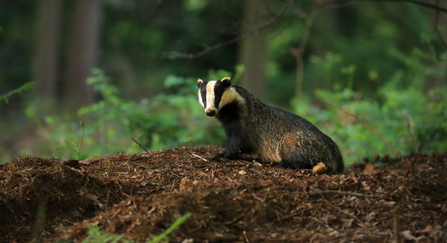
Badger ©Jon Hawkins - Surrey Hills Photography
Badgers
When a confirmed badger sett has been identified a detailed assessment of the land is required to establish the territorial boundaries of the badger social groups using the area and the distribution and status of all local setts. This is to determine which, if any, are in use and to see if there is an alternative sett to which the badgers could move within their own territory. Only the main sett is likely to be in continuous use, and it is threats to the main sett which can have the greatest impact on a badger population.
Survey Timings
Badger surveys can be carried out throughout the year; the most effective time is between March and May when vegetation cover is reduced. Actions that may disturb badgers must be licensed by the appropriate statutory agency and are restricted to the period between 1st July and 30th November.
Licence Application
A licence for works will be required where works are due to take place within 20 metres of a badger sett. Works with heavy machinery require a licence within 30m of a sett.
Upon the completion of survey works, once planning permission has been granted, DWS can submit a licence application Natural England where required.

Daubenton's Bat, myotis daubentoni, adult, flying over water - Dale Sutton/2020vision
Bats
An initial Preliminary Roost Assessment of a building, structure, or tree will identify the potential for roosting bats and identify if further surveys are required to ascertain the presence of bats. Further works may be in the form of nocturnal vantage point surveys and/ or transects, as well as hibernation surveys.
Survey Timings
Initial surveys can be carried out throughout the year, with further surveys restricted by timing constraints. Nocturnal surveys (including transects) can only be undertaken between late May and early September when bats occupy summer roost sites and a status of a roost can be reliably assessed. Hibernation surveys must be carried out over winter months (December – February). Due to survey timing constraints, it is always best to discover any ecological issues in the early stages of your project so there are no delays at a later date.
Licence Application
Once planning permission has been approved a licence application can be made to Natural England. The application requires a mitigation ‘method statement’ describing how bats will be conserved on site after development. Typical mitigation includes avoiding sensitive times of year, supervision of demolition by a licenced ecologist, and providing alternative roosting opportunities/ bat access points.

Otter © Danny Green/2020VISION
Otters
As otters are active all year and live in and alongside a range of aquatic and terrestrial habitats all water bodies and coastal areas within 100 metres of the site boundary should be surveyed with a follow-up more detailed survey undertaken where evidence of otter is found.
DWS have the necessary skills and experience in otter surveying and designing mitigation.
Survey Timings
Surveys can be undertaken at any time of year and must be undertaken by a suitably experienced ecologist. Otters can breed at any time of year, therefore there is no preferred season in which to undertake operations in order to limit disturbance. Works may have to be delayed if otters are found to be breeding on site.
Licence Application
A development licence must be obtained from Natural England for checking holts or for carrying out work that may disturb otters. Licences must be issued prior to commencement of works and should be applied for at least one month in advance. Mitigation measures must also be in place, and only in extreme circumstances will the licensing authority permit the destruction of holts or other otter resting places.

Water vole © Terry Whittaker/2020VISION
Water voles
Development of riparian habitats may result in an offence being committed in relation to water voles, without appropriate survey and mitigation. All riparian habitats will require initial checks for potential to support water voles with follow-up in-depth surveys checking for signs of water vole trails, feeding signs, latrines and burrows, where necessary.
DWS have extensive experience in water vole survey techniques, as well an in-depth knowledge of water vole dispersal within the North East.
Survey Timings
Water vole surveys are normally carried out between April and October when animals are most active. The peak in the survey season is September when population levels are high following the summer breeding season.
Licence Application
Development affecting water vole habitat is not licensable. To avoid committing an offence, steps must be taken to minimise damage to water vole habitat or, ideally, avoid it altogether by a sensitive design approach.
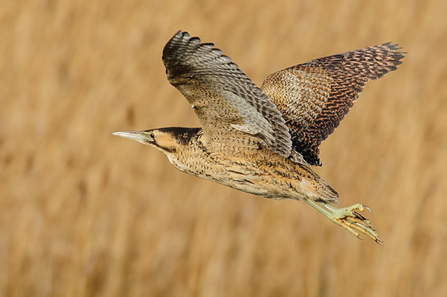
Birds
An initial survey will establish whether the site is suitable for breeding and/ or wintering birds with a special emphasis on Schedule 1 and UKBAP species. If evidence of rare birds or bird breeding habitat is found further surveys may be required.
Further survey work provided includes wintering bird surveys, breeding bird surveys, and specialist surveys for individual protected species such as barn owl. Timings vary for each survey type and our team will be able to provide further information on what surveys you may require after an initial evaluation of the site.
Nesting Bird Survey
Within the bird nesting season, bird nests can be searched for by hand immediately prior to development. This is a last resort and is only practical for small areas of scrub, individual trees and bushes. The number of visits will depend on the size and the importance of key bird species present from the initial survey.
Nesting bird surveys are only required for works taking place between 1st March and 31st August but works should ideally be timed outside of this breeding season.
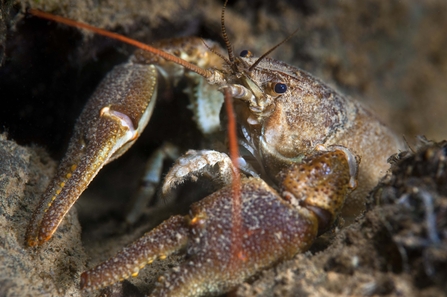
©Alex Mustard/2020VISION
Crayfish
An initial assessment would take into account potential value of any river habitats for protected white-clawed crayfish. Active searching determines presence or likely absence of the species and trapping can be carried out if necessary.
A licence will be required from Natural England to carry out these surveys and all work will be carried out by a competent ecologist with relevant skills, knowledge and experience of working with white-clawed crayfish.
Survey Timings
Habitat assessments can take place at any time of the year, but surveys can only take place from mid-June to the end of September to ensure females are not disturbed whilst carrying eggs.
Licensing
Any activity likely to contravene legislation protecting white-clawed crayfish populations will require a licence. Applications for licences must be submitted to Natural England by a competent ecologist.

Large blue butterfly {Maculinea arion} feeding on Wild Thyme {Thymus praecox}, Collard Hill, Somerset, England, UK. June 2011. - Ross Hoddinott/2020VISION
Crayfish
An initial assessment would take into account potential value of any river habitats for protected white-clawed crayfish. Active searching determines presence or likely absence of the species and trapping can be carried out if necessary.
A licence will be required from Natural England to carry out these surveys and all work will be carried out by a competent ecologist with relevant skills, knowledge and experience of working with white-clawed crayfish.
Survey Timings
Habitat assessments can take place at any time of the year, but surveys can only take place from mid-June to the end of September to ensure females are not disturbed whilst carrying eggs.
Licensing
Any activity likely to contravene legislation protecting white-clawed crayfish populations will require a licence. Applications for licences must be submitted to Natural England by a competent ecologist.
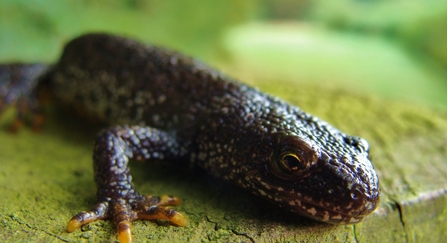
WildNet - Kevin Caster
Newts
A habitat assessment will determine the likelihood of great crested newts being present and how they may be affected by proposed works. Initial assessments must be undertaken on all ponds within 500 metres of a site boundary and follow-up work may be necessary including DNA sampling, egg searching, torching, netting, bottle trapping, and terrestrial searches. All survey techniques can only be carried out by licenced individuals and DWS Ecologists hold the necessary licences and experience to carry out appropriate survey work.
In certain areas of the North East (excluding Sunderland), the District Level Licencing Scheme has been adopted for GCN and involves a paying a fee to commence works, without the need for full surveys or mitigation. Our team will be able to provide guidance on the best approach for your project.
Survey Timing
Surveys to sample a waterbody for GCN DNA are restricted to mid-April to late June and pond surveys are seasonally constrained to mid-March to mid-June. Pond surveys vary from 4 to 6 visits within the survey period. Outside of this season terrestrial surveys can be used to establish presence of animals in terrestrial habitat, excluding November to March. Seasonal constraints and potentially lengthy survey techniques mean that the potential for GCN on site should be addressed as early as possible, to prevent potential delays to projects.
Licence Application and mitigation
Once planning permission has been approved a licence application can be made to Natural England. The application requires a mitigation ‘method statement’ describing how great crested newts will be conserved on site after development. In some areas it may be appropriate to apply for a district level licence; our knowledgeable team will be able to advise on the best route for your project.

©Jon Hawkins
Reptiles
The four widespread species of British reptile: grass snake, slow-worm, adder and common lizard, all of which are legally protected under UK law. The much rarer smooth snake and sand lizard are fully protected under UK and EU law.
A site assessment will identify the potential for reptiles on site and likely impacts of the proposed project. If the assessment reveals that the site has potential, a reptile refugia survey will be required to ascertain presence or likely absence. This involves the distribution of reptile refugia across the site followed by regular inspection by suitably qualified ecologists. Weather conditions are a crucial factor when conducting reptile surveys making expert knowledge essential; DWS have extensive experience in surveying for reptiles, as well as designing mitigation.
Licence Application
Licence applications for disturbances to smooth snake and sand lizard must be accompanied by a ‘method statement’ describing mitigation and how the population will be conserved post-development.
Despite no licence application being necessary, reptiles protected under UK law will also require a mitigation strategy so that planning can be approved.
Survey Timings
Initial and further reptile surveys are carried out between March and October, with the peak survey seasons being April-June and September-October. Timing constraints and potentially lengthy survey work means that potential reptile constraints should be addressed as early as possible to prevent project delays.
